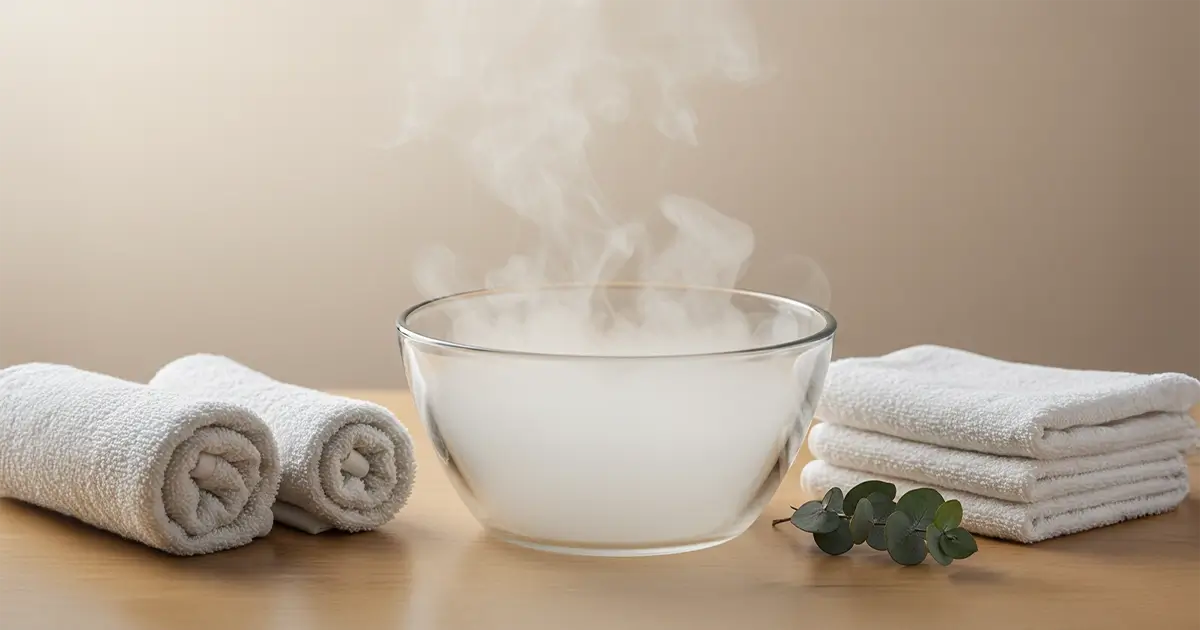Ever draped a towel over your head, leaned over hot water, and pictured your pores swinging wide like tiny doors? Today I explore whether that cinematic scene matches biology, sprinkle in dermatologist research, and share skin-safe ways to get the grime out. Steam, pore size, and facial steaming myths all get a spotlight in this friendly 9-minute read.
Where the Steam-and-Pores Idea Came From
I blame ancient bathhouses first. Roman thermae and Ottoman hammams paired hot air with vigorous scrubbing, so people naturally linked warm mist with cleaner complexions. Fast-forward to modern spas: soft lighting, eucalyptus vapour, and an esthetician announcing that steam "opens" pores. The phrase stuck because it sounds logical and soothing.
Marketing sealed the deal. Home facial steamers often promise a gateway to "opened" pores, making extraction look effortless. When a claim gets repeated by bottles, blogs, and enthusiastic friends, it transforms into folklore faster than you can say comedone.
Yet folklore is not physiology. Pores are simply the surface openings of hair follicles and sweat glands. They are not muscular valves; they cannot gape like windows in summer or slam shut in winter. That single fact already cracks the myth, but let us zoom in a little closer.
The Physiology of Pores
Under the microscope, each pore is a tunnel framed by keratin and surrounded by sebaceous glands. Its diameter is influenced mostly by genetics, oil output, and age-related collagen loss. No muscle fibres guard the entrance, so nothing physically "opens" or "closes" it.
Temperature changes do affect nearby blood vessels. Warmth relaxes capillaries, bringing a rosy flush, while chill constricts them. This visible swelling can trick the eye into thinking the pore itself has expanded. Think of it as an optical illusion created by healthy circulation, not a structural portal swinging open.
What Actually Happens When Skin Meets Steam
Lift the lid on a vegetable steamer and you will feel moist heat swirl upward. Place skin in that path and the stratum corneum - the very top layer - softens. It absorbs water, becoming pliable like damp cardboard. That pliability is the real reason extractions feel easier after steaming.
Moist heat also ramps up cutaneous blood flow. A 2008 Finnish study on regular sauna users found improved stratum corneum hydration and quicker barrier recovery after controlled heat exposure (Int J Biometeorol, 2008). The effect is short-lived, though, and does not translate into permanent pore expansion.
Dermatologist Sara Fulton reminded readers in Dermascope that steaming aids facials by loosening debris, not by unbolting microscopic doors. Once the skin cools, the softening subsides and everything shrinks to its usual blueprint.
Short-Term Perks That Get Mistaken for "Opening"
- Sebum melts. Oil becomes more fluid around 35 °C, sliding toward the surface where it is easier to wipe away.
- Keratins swell, enlarging the follicular opening just enough for blackheads to budge when gentle pressure is applied.
- Circulation surges, giving that "healthy flush" many mistake for detoxification.
Potential Hazards You Should Know
Softened skin is also vulnerable. Over-steaming strips lipids, causing post-session dehydration. People with rosacea or melasma risk flare-ups because dilated vessels and heat trigger redness and pigmentation cascades. A 2022 review on Self.com (SELF Magazine) urges a strict 10-minute cap once per week.
Smart Ways to Clean and "Unclog" Without the Myth
I prefer a multi-step cleanse to a boiling kettle marathon. Start with micellar water to lift sunscreen and makeup, then reach for a gentle, low-pH cleanser. Double cleansing removes more waxy residue than steam and skips the overheating risk.
Chemical exfoliants work like digital precision tools. Salicylic acid dives into oily follicles, dissolving compacted plugs from within. Polyhydroxy acids sweep dead cells off sensitive skin without sting. If you need a refresher, pop over to my earlier post on choosing AHA, BHA, or PHA exfoliants.
Top it off with barrier-friendly moisturisers. Ceramide creams (remember our Ceramides 101 guide) seal hydration so pores look refined, not parched.
Safe-Steaming Checklist (If You Still Love the Ritual)
- Keep water below 45 °C; hotter vapour scalds faster than you can blink.
- Hold your face 25 cm away so droplets fall as mist, not boiling rain.
- Limit sessions to 5–7 minutes once weekly.
- Follow immediately with a hydrating serum - hyaluronic acid loves moist skin.
- Seal with moisturiser rich in lipids to rebuild any melted barrier bits.
Evidence-Based Alternatives
Clay masks soaked in magnesium aluminium silicate absorb oil without heat. Meanwhile, retinoids increase cellular turnover, gradually smoothing follicle edges so they cast smaller shadows and appear downsized.
Want a spa vibe without the myth? Try a warm, damp microfiber cloth press for sixty seconds before massaging cleanser. You get a comfort boost, zero scald risk, and the same debris-loosening effect.
FAQ
Does steaming make pores permanently larger?
No. The follicle opening may look wider while skin is warm and moist, but it retracts once temperature and hydration normalise. Permanent enlargement stems from collagen loss, chronic sun exposure, and genetics.
Can cold water "close" pores after a facial?
Cold water tightens blood vessels, reducing redness, but it does not seal follicle walls. It can, however, soothe post-extraction inflammation.
Is steaming helpful for acne?
It can soften comedones, making professional extractions more comfortable. Alone, it does not treat acne and may worsen inflammatory lesions by boosting blood flow and sweat. Combine with topical retinoids for best results.
Are facial steamers better than a bowl of hot water?
Most tabletop devices produce controlled temperatures and finer mist, lowering burn risk. That said, both rely on the same physics, so safety protocols remain identical.
How often is it safe to steam?
For normal, resilient skin, once a week for under ten minutes suffices. Sensitive or rosacea-prone skin may skip steaming altogether.
Does sweat detoxify skin during steam sessions?
Sweat consists mainly of water and electrolytes. It transports tiny waste molecules, but kidneys and liver handle true detoxification. Steam therapy is about comfort, not toxin removal.
Conclusion
Steam feels luxurious and can loosen the gunk sitting at a pore's doorstep, yet it never swings that door wide open. Understanding the difference saves money, protects the barrier, and keeps expectations realistic.
Got thoughts or steamy stories? Drop them below - see you in the next post, until then, take good care of your skin!
Steam does not open pores, but it can soften debris. Unpack the myth, learn safe deep-cleansing tactics, and keep irritation away.


Comments (0)
No comments yet - be the first to share your thoughts!
Leave a Reply
Your email address will not be published. Required fields are marked *